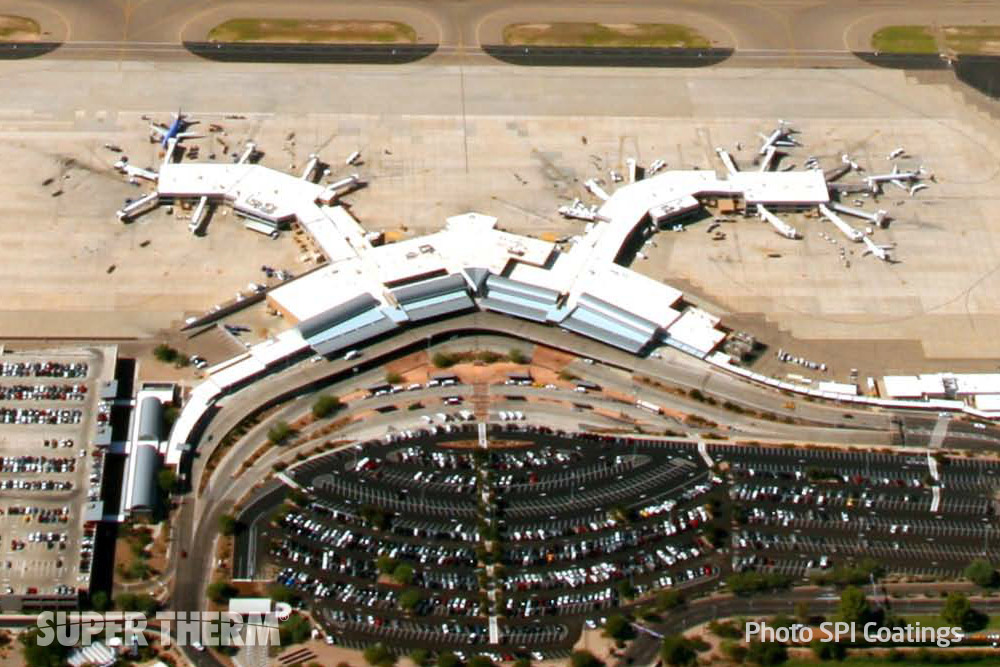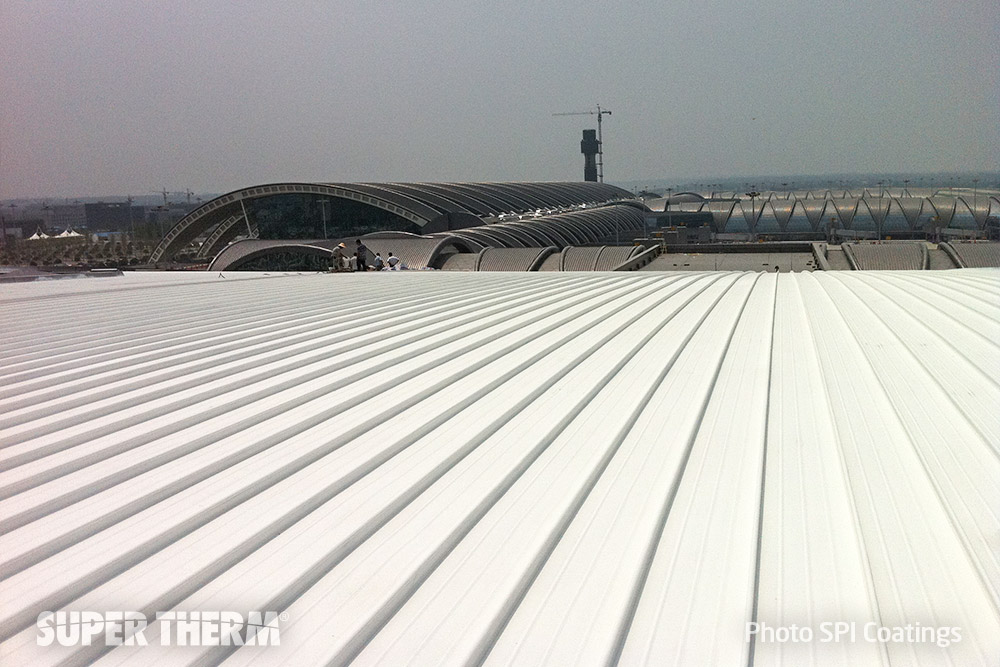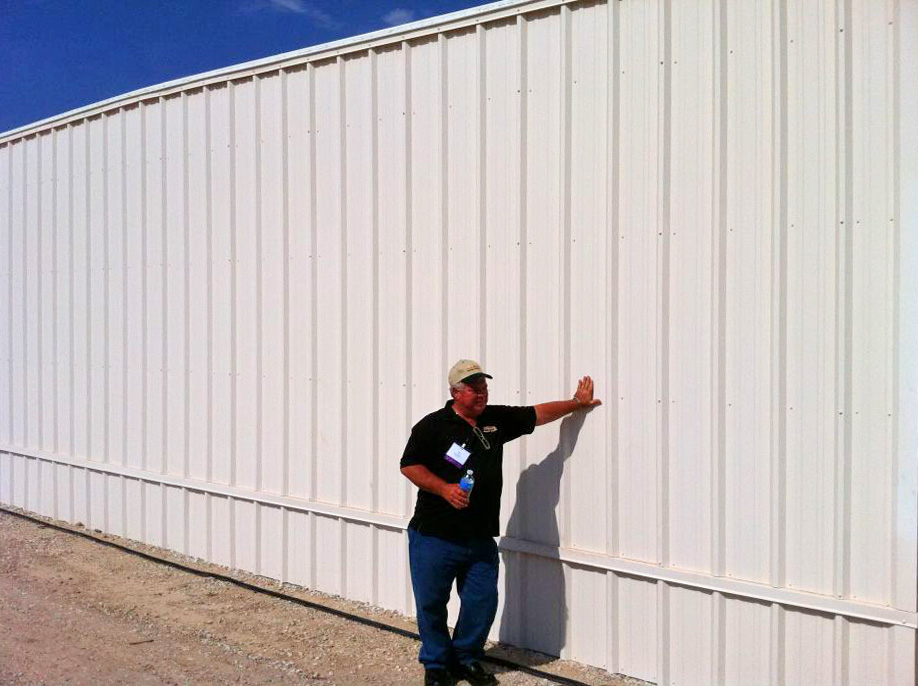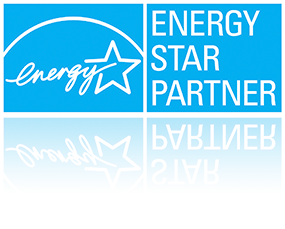Super Therm® – Walkways Coated at Harry Reid International Airport in Las Vegas
Read the article – pdf
Author: Kristen Rindfleisch – Airport Improvement
Published: October, 2023
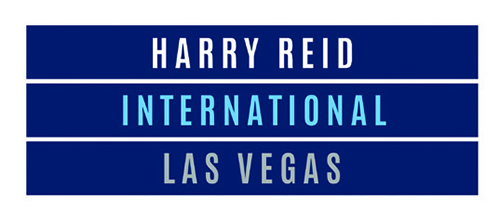
Harry Reid International (LAS) in Las Vegas regularly sees temperatures of more than 100 degrees Fahrenheit (37°C) throughout the summer, requiring significant energy to cool its passenger boarding bridges. The Clark County Department of Aviation, which operates LAS, has opted to have a reflective ceramic coating applied to bridge exteriors to help keep the interiors more comfortable for passengers. The strategy will also save energy and prolong the life of the airport’s preconditioned air units, as well as the jet bridges themselves.
When temperatures at the southwest desert airport soar, the external surface temperature of its metal boarding bridges can exceed 200 degrees Fahrenheit (93°C), and most of that heat radiates into the boarding bridges.
Doug McMahan
Managing Director for Facilities and Maintenance with the Clark County Department of Aviation

When temperatures at the southwest desert airport soar, the external surface temperature of its metal boarding bridges can exceed 200 degrees Fahrenheit (93°C), and most of that heat radiates into the boarding bridges. “We wanted not only more efficient preconditioned air units, which we’re looking into, but it was really more about how we could reduce the cooling curve, if you will, to get that temperature down to better ambient temperatures,” says Doug McMahan, managing director for Facilities and Maintenance with the Clark County Department of Aviation. “So, we wanted to look at something innovative.”
Facts & Figures
Project: Solar Heat-Resistant Coating for Boarding Bridges
Location: Harry Reid Int’l Airport in Las Vegas
Scope: About 100 jet bridges
Status: 70 have been coated since 2017; remaining 44 will be treated as they come due for electronic refurbishment in next 2 years
Cost Per Bridge: Similar to standard paint
Product: Super Therm®, by SPI Coatings
Application Contractor: Southwest Specialty Coatings Inc., sister company of Cor-Ray Painting
Timeline: Application takes 7–10 days per bridge; coating is applied when bridge is taken out of service for electronic refurbishments
Key Benefits: Reduces cooling time & energy consumption; improves passenger comfort; reduces wear & tear on preconditioned air units; extends life of jet bridges
Associated SPI Coatings Products: Enamo Grip topcoat for sides of bridges; Enamo Grip 5000 topcoat for rotating rotunda segments; Rust Grip® corrosion protection for components showing signs of rust
Testing and Results
McMahan found just that through a construction management consultant who was discussing a coating product (Super Therm®) while working with other local public entities.
Aviation Department personnel began general testing of Super Therm®, a reflective ceramic coating manufactured by SPI Coatings, in 2017. For reference, the company offers two kinds of ceramic coatings generally applicable to jet bridges: HPC® Coating, which is a thick-film, insulating coating applied on the inside to block conductive heat transfer; and Super Therm®, a thin-film, reflective coating usually applied on the exterior to insulation and repel most of the solar radiation heat.
SPI Coatings Vice President of Business Development and Technology Timothy Cappel explains that Super Therm® does not absorb heat from the sun. “That’s the benefit,” he remarks. “If it doesn’t absorb the heat, then there is no heat transfer to the inside of the passenger walkways.”
In 2018, LAS began testing the ceramic coating on passenger boarding bridges that face southwest, because they receive the most radiant heat. Typically, a preconditioned air unit starts cooling the jet bridge 20 to 30 minutes before a flight arrives. It does so by taking hot outside air and chilling it with air between 28 and 34 degrees Fahrenheit. After the aircraft parks at the gate, it is connected with exterior hoses, and the cooling system is switched from bridge mode to aircraft mode so the aircraft can turn off its auxiliary power unit and stop burning fuel to cool the air on board.
NOTE: Laboratory and Field project results as stated here may vary according to different climate conditions.
“If it doesn’t absorb the heat, then there is no heat transfer to the inside of the passenger walkways.”
Timothy Cappel – SPI Coatings Vice President of Business Development and Technology
To test the performance of Super Therm®, the project team recorded temperatures inside the bridges before starting the preconditioned air units, and also measured the time needed to cool them. McMahan reports that coated bridges were cooler to begin with—staying with a few degrees of ambient temperatures even as the day warmed up—and also cooled down faster. “The bridge was able to maintain a lower setpoint when we switched over to the aircraft mode,” he adds.
Phased Implementation
After extensive testing for the better part of two years, the Clark County Department of Aviation decided to incorporate Super Therm® into the ongoing refurbishment of all JBT AeroTech boarding bridges at LAS. The coating manufacturer recruited Southwest Specialty Coatings for installation. And in 2019, the contractor began applying Super Therm® to jet bridges as they were pulled from service to receive updated electronic components and controls.
“We try to take advantage of when those bridges are going to be closed anyways,” McMahan explains.
So far, crews have coated approximately 70 jet bridges; the remaining 44 will be coated over the next two years as they come due for other refurbishment.
McMahan notes that the cost is about the same as repainting bridges with a standard paint product. “It’s obviously well worth that for the benefits we derive,” he says.
“It’s obviously well worth that for the benefits we derive”
The reflective ceramic coating helps drop the interior temperature of the jet bridges to within three or four degrees of the ambient air temperature, but that is still quite hot many days. “Usually on the inside of a metal shell like that, it can climb up to 130 or 140 degrees easily,” says Justin Leavitt, operations manager at Southwest Specialty Coatings.
In general, travelers are unlikely to notice the temperature on a jet bridge unless it’s extremely hot or cold. If passengers at LAS don’t notice extreme heat, that indicates the coating is doing its job. “Even though they may be walking through and not even realize it, it’s more comfortable,” Leavitt notes.
Application Process
Crews apply Super Therm® onto the roof and exterior sides of the jet bridges and also onto the rotating rotunda segments. Enamo Grip, another product from SPI Coatings, is applied on the sides of the bridges as a topcoat, but the roofs do not need it, Cappel advises. Enamo Grip 5000 is used as a topcoat on the rotunda segments for added protection against the additional movement and wear. Rust Grip®, a corrosion protection coating from SPI Coatings, is applied to any rails or other components showing signs of rust.
Applying Super Therm® isn’t as simple as spraying on a fresh coat of paint, McMahan notes. The physical composition and viscosity of the material are unique, requiring special equipment and techniques. Contractors consequently need to be trained and certified by SPI Coatings to ensure quality and guarantee integrity of the product throughout its 10-year general product limited warranty. “SPI Coatings was definitely the firm that just knocked it out of the park for us,” McMahan remarks. “Their quality was phenomenal, and they stand behind their product.”
“SPI Coatings was definitely the firm that just knocked it out of the park for us”
Doug McMahan
Managing Director for Facilities and Maintenance with the Clark County Department of Aviation
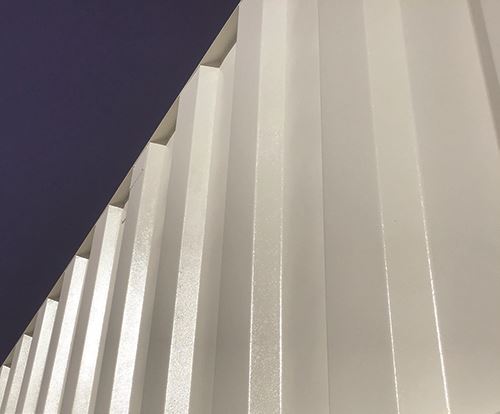
Naturally, coordination has been crucial during the phased applications at LAS. “We have to communicate well, so the [boarding bridge] is down for as minimal time as possible,” says Leavitt. “It’s really just sequencing—making sure we schedule things correctly with the intricacies of getting in and out of the airport property.”
Each boarding bridge takes about seven to 10 days to coat, and work is completed onsite at LAS. The only preparation for airport personnel is extending the bridge to its full length so technicians can work on the entire structure. Crews from Southwest Specialty Coatings set up a barrier to protect the area around the jet bridge as they work. There is virtually no impact on travelers or airport operations.
Barring extreme weather conditions or bonding problems during application, Super Therm® can last 25 to 30 years before it may need to be reapplied, says Cappel. When that time comes, a new layer can be applied directly over the previous coating.
Super Therm® can last 25 to 30 years with Enamo Grip in extreme weather conditions
Timothy Cappel – SPI Coatings Vice President of Business Development and Technology
Efficiencies and Benefits
Because it takes less time to cool coated bridges, the airport’s preconditioned air units will consume less energy and presumably last longer because they are running for shorter periods of time. Moreover, the ceramic coating is expected to extend the life of the bridges because it is thicker than regular paint, eliminates expansion and contraction of the metal structure and provides a buffer to everyday wear and corrosion.
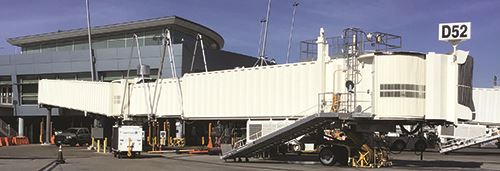
The coating also benefits maintenance staff and technicians working on the exterior of the jet bridges. “The ones with the coating stay about one to three degrees from what the exterior ambient temperature is outside,” McMahan reports. “That is phenomenal.”
“The ones with the coating stay about one to three degrees from what the exterior ambient temperature is outside,” … “That is phenomenal.”
Doug McMahan
Previously, maintenance and repairs on boarding bridges had to be performed at night, because the structures were simply too hot to touch. Now, technicians can work on the coated jet bridges during the day. “They basically can lay on the surface with their bare skin and never be uncomfortable or burn themselves,” Cappel remarks.
As other infrastructure projects arise at LAS, Clark County Department of Aviation will consider testing and using Super Therm®, perhaps on buildings or rooftop air-conditioning units. Other southwest U.S. airports, including Tucson International, use Super Therm® on roofs and storage facilities.
McMahan sees even wider potential, noting that airports in rainy regions could benefit from the product’s rust protection qualities, and SPI Coatings’ interior product could help increase insulation values for jet bridges at cold weather airports. “If you were doing a refurb, getting down to the bare metal, it might be worth looking at,” McMahan suggests.
Read the article – pdf
Read the Airport Improvements article
Other Aviation Heat Management Projects







